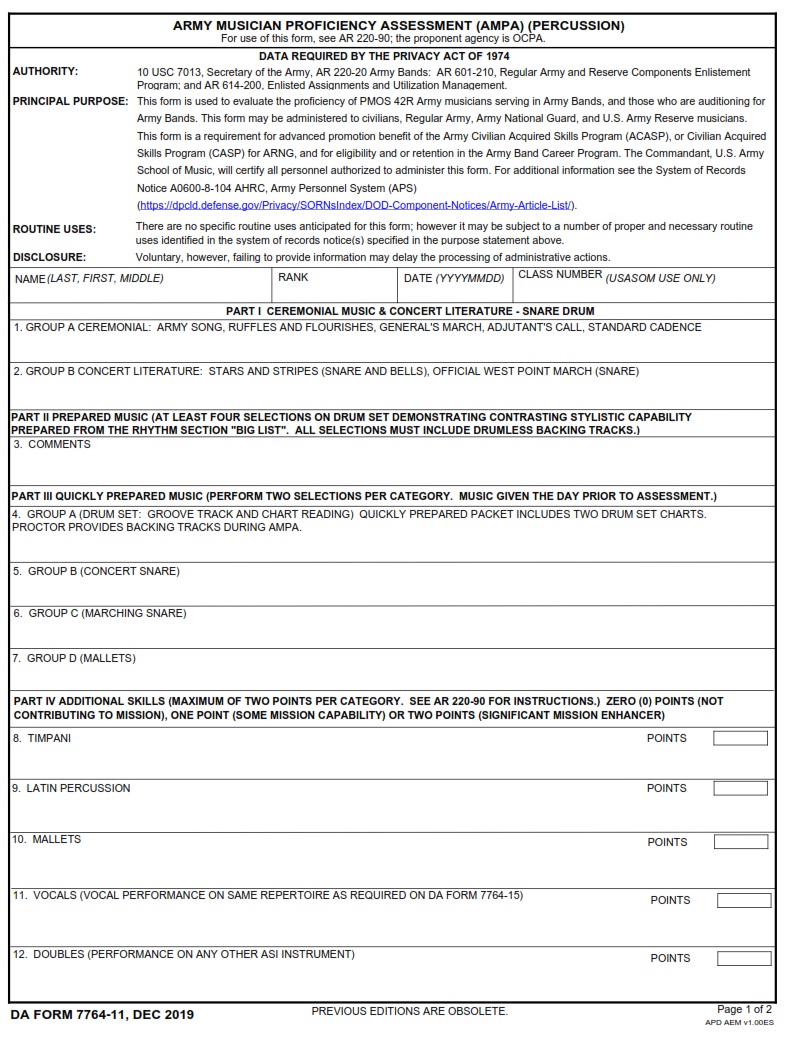Table of Contents
FREE-ONLINE-FORMS.COM – DA Form 7764-11 – Army Musician Proficiency Assessment (AMPA) (Percussion) – The Army Musician Proficiency Assessment (AMPA) is a comprehensive evaluation tool used by the U.S. Army to assess the skills and knowledge of its musicians. It was developed to ensure that all Army musicians meet or exceed the standards required for their assigned duties. The DA Form 7764-11 is specifically designed for percussionists, who play an essential role in military bands and ensembles.
The AMPA evaluates a wide range of skills, including sight-reading, technical proficiency, and musical interpretation. It also assesses the musician’s ability to work effectively as part of a team and respond quickly to changing situations. The assessment involves both written exams and practical demonstrations of skill, providing a comprehensive evaluation of each musician’s abilities.
Download DA Form 7764-11 – Army Musician Proficiency Assessment (AMPA) (Percussion)
| Form Number | DA Form 7764-11 |
| Form Title | Army Musician Proficiency Assessment (AMPA) (Percussion) |
| Edition Date | 12/1/2019 |
| File Size | 47 KB |
What is a DA Form 7764-11?
The DA Form 7764-11 is a form used by the U.S. Army to assess the proficiency of percussion musicians. The assessment is known as the Army Musician Proficiency Assessment (AMPA). The form is used to record and evaluate the musician’s skill level in areas such as sight-reading, performance technique, and musical knowledge.
In order to complete the AMPA assessment using DA Form 7764-11, a certified music instructor must observe and grade the musician’s performance. The instructor will evaluate technical skills such as stick control, dynamics, timing, and rhythm accuracy. Additionally, they will evaluate how well the musician performs with an ensemble or group.
After completing the AMPA assessment using DA Form 7764-11, musicians may be recommended for further training or advancement opportunities within their unit. This evaluation process helps ensure that Army musicians are meeting established standards and maintaining a high level of proficiency in their craft.
Where Can I Find a DA Form 7764-11?
The DA Form 7764-11, also known as the Army Musician Proficiency Assessment for Percussion, is an essential document that every percussionist in the army must have. This form helps to assess and evaluate an individual’s skills and abilities in playing various percussion instruments. However, locating this form can be a daunting task for many people.
One of the easiest ways to find the DA Form 7764-11 is by visiting the official website of the United States Army. On this site, you will find a wide range of forms used in different departments within the army. The DA Form 7764-11 should be listed under music or personnel management.
Another option is to reach out to your commanding officer or supervisor who can direct you on where to acquire the form. They may provide you with a copy or advise you on where else it can be found. It’s important to keep in mind that these forms are usually not available for public access and must be obtained through authorized channels only.
DA Form 7764-11 – Army Musician Proficiency Assessment (AMPA) (Percussion)
The DA Form 7764-11 is a critical tool used in the Army Musician Proficiency Assessment (AMPA) program specifically designed for percussionists. The AMPA program aims to ensure that all Army musicians meet or exceed the standard requirements of their assigned duties. This form evaluates the proficiency levels of percussionists across five different areas, including snare drum, mallet keyboard instruments, timpani, drum set, and other auxiliary percussion instruments.
Percussionists must complete this form annually to demonstrate their skills and knowledge of proper techniques in each area assessed. The scores are then recorded on their official record and used as a basis for advancement or promotion within the music program. The DA Form 7764-11 helps maintain a high level of musical proficiency within the Army’s music program by providing objective measures of performance that can be compared over time to identify areas where improvement is needed. It also serves as an essential tool for instructors to provide feedback and guidance to help musicians develop their skills further.

